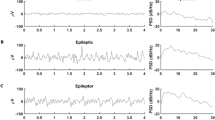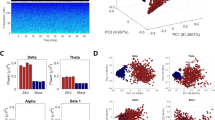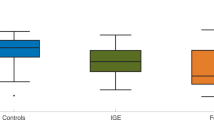Abstract
The mechanism of seizure emergence and the role of brief interictal epileptiform discharges (IEDs) in seizure generation are two of the most important unresolved issues in modern epilepsy research. We found that the transition to seizure is not a sudden phenomenon, but is instead a slow process that is characterized by the progressive loss of neuronal network resilience. From a dynamical perspective, the slow transition is governed by the principles of critical slowing, a robust natural phenomenon that is observable in systems characterized by transitions between dynamical regimes. In epilepsy, this process is modulated by synchronous synaptic input from IEDs. IEDs are external perturbations that produce phasic changes in the slow transition process and exert opposing effects on the dynamics of a seizure-generating network, causing either anti-seizure or pro-seizure effects. We found that the multifaceted nature of IEDs is defined by the dynamical state of the network at the moment of the discharge occurrence.
This is a preview of subscription content, access via your institution
Access options
Access Nature and 54 other Nature Portfolio journals
Get Nature+, our best-value online-access subscription
$29.99 / 30 days
cancel any time
Subscribe to this journal
Receive 12 print issues and online access
$209.00 per year
only $17.42 per issue
Buy this article
- Purchase on Springer Link
- Instant access to full article PDF
Prices may be subject to local taxes which are calculated during checkout








Similar content being viewed by others
Data availability
The data that support the findings of this study are available from the corresponding author upon reasonable request.
References
Fisher, R. S. et al. ILAE official report: a practical clinical definition of epilepsy. Epilepsia 55, 475–482 (2014).
Jiruska, P. et al. Synchronization and desynchronization in epilepsy: controversies and hypotheses. J. Physiol. (Lond.) 591, 787–797 (2013).
Jirsa, V. K., Stacey, W. C., Quilichini, P. P., Ivanov, A. I. & Bernard, C. On the nature of seizure dynamics. Brain 137, 2210–2230 (2014).
Lopes da Silva, F. Epilepsy as a disease of the dynamics of neuronal networks: models and predictions. In Seizure Prediction in Epilepsy: From Basic Mechanisms to Clinical Applications (eds. Schelter, B., Timmer, J. & Schulze-Bonhage, A.) 97–107 (Wiley-VCH, Weinheim, Germany, 2008).
Beghi, E. et al. Recommendation for a definition of acute symptomatic seizure. Epilepsia 51, 671–675 (2010).
Breakspear, M. et al. A unifying explanation of primary generalized seizures through nonlinear brain modeling and bifurcation analysis. Cereb. Cortex 16, 1296–1313 (2006).
Lopes da Silva, F. et al. Epilepsies as dynamical diseases of brain systems: basic models of the transition between normal and epileptic activity. Epilepsia 44 (Suppl 12), 72–83 (2003).
de Curtis, M. & Avanzini, G. Interictal spikes in focal epileptogenesis. Prog. Neurobiol. 63, 541–567 (2001).
Avoli, M., de Curtis, M. & Köhling, R. Does interictal synchronization influence ictogenesis? Neuropharmacology 69, 37–44 (2013).
Barbarosie, M. & Avoli, M. CA3-driven hippocampal-entorhinal loop controls rather than sustains in vitro limbic seizures. J. Neurosci. 17, 9308–9314 (1997).
Karoly, P. J. et al. Interictal spikes and epileptic seizures: their relationship and underlying rhythmicity. Brain 139, 1066–1078 (2016).
Avoli, M. & de Curtis, M. GABAergic synchronization in the limbic system and its role in the generation of epileptiform activity. Prog. Neurobiol. 95, 104–132 (2011).
Huberfeld, G. et al. Glutamatergic pre-ictal discharges emerge at the transition to seizure in human epilepsy. Nat. Neurosci. 14, 627–634 (2011).
Rinaldi, S. & Scheffer, M. Geometric analysis of ecological models with slow and fast processes. Ecosystems 3, 507–521 (2000).
Scheffer, M. et al. Anticipating critical transitions. Science 338, 344–348 (2012).
Scheffer, M. et al. Early-warning signals for critical transitions. Nature 461, 53–59 (2009).
Draguhn, A., Traub, R. D., Schmitz, D. & Jefferys, J. G. Electrical coupling underlies high-frequency oscillations in the hippocampus in vitro. Nature 394, 189–192 (1998).
Jiruska, P. et al. High-frequency network activity, global increase in neuronal activity, and synchrony expansion precede epileptic seizures in vitro. J. Neurosci. 30, 5690–5701 (2010).
Lopes, M. A., Lee, K. E. & Goltsev, A. V. Neuronal network model of interictal and recurrent ictal activity. Phys. Rev. E 96, 062412 (2017).
Kalitzin, S., Velis, D., Suffczynski, P., Parra, J. & da Silva, F. L. Electrical brain-stimulation paradigm for estimating the seizure onset site and the time to ictal transition in temporal lobe epilepsy. Clin. Neurophysiol. 116, 718–728 (2005).
Scheffer, M. & Carpenter, S. R. Catastrophic regime shifts in ecosystems: linking theory to observation. Trends Ecol. Evol. 18, 648–656 (2003).
Hawkins, C. A. & Mellanby, J. H. Limbic epilepsy induced by tetanus toxin: a longitudinal electroencephalographic study. Epilepsia 28, 431–444 (1987).
Jiruska, P. et al. Epileptic high-frequency network activity in a model of non-lesional temporal lobe epilepsy. Brain 133, 1380–1390 (2010).
Cook, M. J. et al. Prediction of seizure likelihood with a long-term, implanted seizure advisory system in patients with drug-resistant epilepsy: a first-in-man study. Lancet Neurol. 12, 563–571 (2013).
Wendling, F., Bartolomei, F., Bellanger, J. J. & Chauvel, P. Epileptic fast activity can be explained by a model of impaired GABAergic dendritic inhibition. Eur. J. Neurosci. 15, 1499–1508 (2002).
Fröhlich, F., Sejnowski, T. J. & Bazhenov, M. Network bistability mediates spontaneous transitions between normal and pathological brain states. J. Neurosci. 30, 10734–10743 (2010).
de Curtis, M. & Avoli, M. Initiation, Propagation, and Termination of Partial (Focal) Seizures. Cold Spring Harb. Perspect. Med. 5, a022368 (2015).
Suffczynski, P. et al. Dynamics of epileptic phenomena determined from statistics of ictal transitions. IEEE Trans. Biomed. Eng. 53, 524–532 (2006).
Scheffer, M. Critical Transitions in Nature and Society (Princeton University Press, Princeton, NJ, USA, 2009).
Kramer, M. A. et al. Human seizures self-terminate across spatial scales via a critical transition. Proc. Natl. Acad. Sci. USA 109, 21116–21121 (2012).
van de Leemput, I. A. et al. Critical slowing down as early warning for the onset and termination of depression. Proc. Natl. Acad. Sci. USA 111, 87–92 (2014).
Jiruska, P., Mormann, F. & Jefferys, J.G.R. Neuronal and network dynamics preceding experimental seizures. in R ecent Advances in Predicting and Preventing Epileptic Seizures (eds. Tetzlaff, R. & Elger, C.E.) 16–29 (2013).
Blauwblomme, T., Jiruska, P. & Huberfeld, G. Mechanisms of ictogenesis. Int. Rev. Neurobiol. 114, 155–185 (2014).
Jensen, M. S. & Yaari, Y. The relationship between interictal and ictal paroxysms in an in vitro model of focal hippocampal epilepsy. Ann. Neurol. 24, 591–598 (1988).
Gotman, J. & Marciani, M. G. Electroencephalographic spiking activity, drug levels, and seizure occurrence in epileptic patients. Ann. Neurol. 17, 597–603 (1985).
Avoli, M. et al. Specific imbalance of excitatory/inhibitory signaling establishes seizure onset pattern in temporal lobe epilepsy. J. Neurophysiol. 115, 3229–3237 (2016).
de Curtis, M., Librizzi, L. & Biella, G. Discharge threshold is enhanced for several seconds after a single interictal spike in a model of focal epileptogenesis. Eur. J. Neurosci. 14, 174–178 (2001).
Muldoon, S. F. et al. GABAergic inhibition shapes interictal dynamics in awake epileptic mice. Brain 138, 2875–2890 (2015).
Avoli, M. et al. Synchronous GABA-mediated potentials and epileptiform discharges in the rat limbic system in vitro. J. Neurosci. 16, 3912–3924 (1996).
Bikson, M., Fox, J. E. & Jefferys, J. G. Neuronal aggregate formation underlies spatiotemporal dynamics of nonsynaptic seizure initiation. J. Neurophysiol. 89, 2330–2333 (2003).
Suffczynski, P., Kalitzin, S. & Lopes Da Silva, F. H. Dynamics of non-convulsive epileptic phenomena modeled by a bistable neuronal network. Neuroscience 126, 467–484 (2004).
Benjamin, O. et al. A phenomenological model of seizure initiation suggests network structure may explain seizure frequency in idiopathic generalised epilepsy. J. Math. Neurosci. 2, 1 (2012).
Naze, S., Bernard, C. & Jirsa, V. Computational modeling of seizure dynamics using coupled neuronal networks: factors shaping epileptiform activity. PLoS Comput. Biol. 11, e1004209 (2015).
Kim, J. W., Roberts, J. A. & Robinson, P. A. Dynamics of epileptic seizures: evolution, spreading, and suppression. J. Theor. Biol. 257, 527–532 (2009).
Jensen, M. S. & Yaari, Y. Role of intrinsic burst firing, potassium accumulation, and electrical coupling in the elevated potassium model of hippocampal epilepsy. J. Neurophysiol. 77, 1224–1233 (1997).
Traynelis, S. F. & Dingledine, R. Potassium-induced spontaneous electrographic seizures in the rat hippocampal slice. J. Neurophysiol. 59, 259–276 (1988).
Williams, P. A. et al. Development of spontaneous recurrent seizures after kainate-induced status epilepticus. J. Neurosci. 29, 2103–2112 (2009).
Baud, M. O. et al. Multi-day rhythms modulate seizure risk in epilepsy. Nat. Commun. 9, 88 (2018).
Saggio, M. L., Spiegler, A., Bernard, C. & Jirsa, V. K. Fast-slow bursters in the unfolding of a high codimension singularity and the ultra-slow transitions of classes. J. Math. Neurosci. 7, 7 (2017).
Cook, M. J. et al. Human focal seizures are characterized by populations of fixed duration and interval. Epilepsia 57, 359–368 (2016).
Acknowledgements
This study was supported by grants of the Czech Science Foundation GACR 14-02634S (to P.J.), Neuron Fund for Support of Science (to P.J.), the Ministry of Health of the Czech Republic AZV 15-29835A (to P.J.), 17-28427A (to P.J.), the Medical Research Council G0802162 (to J.G.R.J.), and the James Lewis Foundation through Epilepsy Research UK P1402 (to J.G.R.J.).
Author information
Authors and Affiliations
Contributions
P.J., J.G.R.J., W.-C.C., J.C., J.H., and M.J.C. conceived the study and designed the experiments. A.D.P., W.-C.C., P.J., J.K., J.O., J.H., J.C., M.I.M., M.J.C., P.J.K., and D.R.F. performed the experiments. W.-C.C., P.J., J.O., M.P., V.K., J.K., J.H., R.J., R.C., A.D.P., J.G.R.J., M.I.M., M.J.C., P.J.K., and D.R.F. analyzed the data. W.-C.C., P.J., J.G.R.J., J.H., and J.K. wrote the manuscript.
Corresponding authors
Ethics declarations
Competing interests
The authors declare no competing interests.
Additional information
Publisher’s note: Springer Nature remains neutral with regard to jurisdictional claims in published maps and institutional affiliations.
Integrated supplementary information
Supplementary Figure 1 Current source density profile of HFA.
(a) The laminar profile of an averaged HFA cycle in the isolated CA1 is characterized by maximal field potential negativity at the stratum pyramidale. (b) Current source density profile and its contour plot (c) reveal that the HFA cycle is accompanied by an initial current sink at the pyramidal layer, which then back-propagates along the dendritic region. On a cellular level, the current source density profile corresponds to dendritic back-propagation of action potentials generated at the soma. (d) Current source density profile for an episode of HFA with superimposed band-passed (100-300 Hz) filtered signal recorded in the stratum pyramidale. (e-h) Laminar profile and current source density of HFA in intact hippocampal preparations display similar features (n=10 slices).
Supplementary Figure 2 Spatial distribution of HFA.
(a) Averaged normalized power spectra of interictal signals in the isolated CA1 demonstrate a clear peak in the high-frequency band due to the presence of HFA. (b) Recording with multiple electrodes demonstrated that HFA was present across the entire CA1. Normalized power spectra in each region were color-coded to display the spatial properties of the spectral profile. (c) Mean power spectra of the signal recorded in CA1 of the intact hippocampus between seizures. (d) Spatial analysis of the spectral profile also demonstrates the presence of HFA in the entire CA1 region. The HFA peak is around 180 Hz, while lower frequency peaks correspond to spectral components of IEDs. (n=10 isolated CA1 slices, and n=10 intact hippocampal slices).
Supplementary Figure 3 Seizures are preceded by an increased sensitivity to external perturbations and delayed recovery from them.
(a) Regular stimulation of constant intensity was delivered to Schaffer collaterals to explore the dynamical state of the CA1 network. (b) The properties of evoked responses were quantified using the line length parameter, which combines information about changes in amplitude, morphology and duration of the response. Seizures are preceded by an increase in the line length – due to increasing sensitivity to stimulation (perturbation) in advance of a seizure. It is reflected by increased amplitude, the occurrence of multiple population spikes and a longer duration of the response (c-e). Delayed recovery from perturbation and increased sensitivity are the main markers of losing resilience and critical slowing in the dynamical system.
Supplementary Figure 4 The laminar profile of IEDs.
(a) IEDs triggered in the CA3 propagate to the CA1 where they induce IEDs. (b,c) Current source density analysis reveals that CA1 IEDs are due to a current sink at the region of the middle apical dendrites and basal dendrites flanked by sources in the distal radiatum as well as the pyramidale. The slow wave following the IEDs is characterized by sources in the same regions with a passive sink in the somatic region. Observed current source density profile suggests that at the cellular level the IEDs in CA1 are due to postsynaptic excitation at the middle part of apical dendrites.
Supplementary Figure 5 Modeling the transition to seizure.
(a) Transitions between interictal state and seizure were modeled as a slow-fast process, where the slow variable represents a change in excitability and the fast variable is a mean population firing rate. For extremely low or high values of excitability only one equilibrium state exists; either the interictal (low firing) or the seizure (high-firing) state, respectively. For intermediate values of excitability, the system has two equilibrium states separated by unstable fixed (tipping) points. (b) If the excitability is dynamically changing, then the system periodically oscillates between these two states and in a phase portrait it has a character of a limit cycle. If the interictal excitability crosses the catastrophic bifurcation F1 the system undergoes a rapid and large shift to a seizure regime. The reverse situation occurs if the excitability during seizure reaches the second catastrophic bifurcation F2 when the seizure suddenly terminates. (c) The corresponding time series demonstrates a repeated transition between the contrasting dynamical regimes, i.e. interictal and seizure states.
Supplementary Figure 6 The complex effect of interictal perturbations on the transition to seizure in the modified Epileptor model.
(a) The transition between interictal state and seizure in the Epileptor model is characterized by a saddle-node bifurcation. (b) The Epileptor model captures both slow processes and faster dynamics, replicating local field potentials during seizure respectively. (c,d) Introduction of less frequent but stronger interictal perturbations increases the probability of the transition to seizure. (e,f) Increasing the frequency of perturbations decreases the probability of the transition to seizure, or it can result in complete cessation of seizures (g,h). (i) Map of combinations of perturbation parameters, i.e. frequency and amplitude and their resulting impact on ictogenesis.
Supplementary Figure 7 Epileptic bursts in the tetanus toxin model of temporal lobe epilepsy.
(a) Multi-day intercluster recording from the right hippocampus, which was injected with the tetanus toxin. (b) Bursts originate in the injected right hippocampus. They are characterized by initial high-amplitude discharges followed by a burst of rhythmic activity. (c,d) With the approaching next cluster of seizures, the duration and rate of bursts increases, as well as, propagation to the contralateral hippocampus and motor cortices of both hemispheres (n = 6/6 intercluster periods/animals; 1041.3±149.2 bursts per cluster). MCxL – left motor cortex, MCxR – right motor cortex, HippL – left hippocampus, HippR – right hippocampus.
Supplementary Figure 8 Temporal profiles of the variance derived from intracranial recordings in 12 patients implanted with seizure prediction devices.
The temporal evolution of signal variance three hours before a seizure, is shown. The dashed line marks 30 minutes before the seizure during which the variance was analyzed. In two patients significant pre-seizure increases in variance were observed. In five patients, the variance significantly decreased. N denotes the number of recorded seizures in each patient. P marks the value of Wilcoxon sign-rank test. The sign after the p-value indicates whether right-tailed (+) or left-tailed (–) Wilcoxon sign-rank test was significant. Lines and shaded lines represent mean and s.e.m. respectively.
Supplementary information
Supplementary Figures 1–8
Supplementary Figures 1–8
Supplementary Video 1
The dynamics of the slow–fast process in the absence of perturbations.
Supplementary Video 2
The dynamics of the slow–fast process in the presence of frequent low-amplitude perturbations. Perturbations increased the distance from the catastrophic bifurcation and slowed the transition to seizure. If the system is approaching the tipping point, even small perturbations can initiate the seizure.
Supplementary Video 3
The dynamics of the slow–fast process in the presence of sparse large-amplitude perturbations. Large amplitude perturbations had a stronger seizure inducing capacity, and they could initiate seizures far in advance of the catastrophic bifurcation.
Supplementary Video 4
The dynamics of the slow–fast process in the presence of frequent large-amplitude perturbations. The presence of perturbations results in complete abolition of seizures.
Rights and permissions
About this article
Cite this article
Chang, WC., Kudlacek, J., Hlinka, J. et al. Loss of neuronal network resilience precedes seizures and determines the ictogenic nature of interictal synaptic perturbations. Nat Neurosci 21, 1742–1752 (2018). https://doi.org/10.1038/s41593-018-0278-y
Received:
Accepted:
Published:
Issue Date:
DOI: https://doi.org/10.1038/s41593-018-0278-y
This article is cited by
-
Computational modeling allows unsupervised classification of epileptic brain states across species
Scientific Reports (2023)
-
Canard solutions in neural mass models: consequences on critical regimes
The Journal of Mathematical Neuroscience (2021)
-
Neural fragility as an EEG marker of the seizure onset zone
Nature Neuroscience (2021)
-
Thalamic deep brain stimulation modulates cycles of seizure risk in epilepsy
Scientific Reports (2021)
-
Proteins related to ictogenesis and seizure clustering in chronic epilepsy
Scientific Reports (2021)



